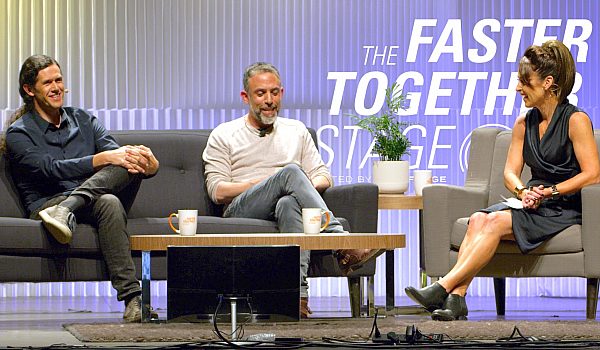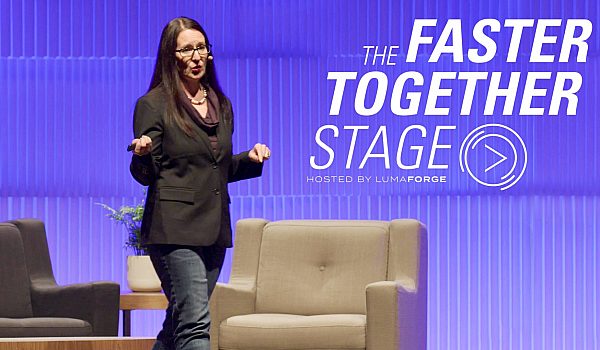Sam Mestman & Gergana Angelova from LumaForge kickoff Faster, Together at NAB 2018. Gergana announces the new backend for the LumaForge Jellyfish, while Sam talks about a number of opportunities LumaForge has had to help customers solve creative and workflow problems.
- Hey guys, what's happening? Thank you guys for making us the first stop on the show floor. I am shocked that you guys are here first but I'm happy and excited because we are gonna have some fun. This is gonna be an awesome three days. Welcome to Faster Together at NAB 2018.
I am Sam Mestman, president of LumaForge and I'm here to talk to you about one thing, which is that I have the best job in the world. I'm continued to be confused as to how this is happening but basically I get to solve problems for some of the smartest people in our industry and I get to see what our customers go and deal with products and their workflows that have not been done before.
The amount of people that I have gotten to meet along the way because we started this bizarre shared storage company that is actually not really a shared storage company, we're actually a workflow company that happens to solve the problem of shared storage. The people that I had met along the way are, continue to amaze me with what they're doing and what they're building around the world. As most of you guys know, we started this company to solve a problem specifically for Final Cut X Professional Workflows and the customers that have come through our door and the community that has been built around what we do has been extraordinary.
A perfect example, a case study that came out last week is VGTV in Norway. Christian Patterson's gonna be here this week but he is one of the smartest people you have never met in post-production. A couple years ago at IBC he kinda politely walked in as he did and he's like, I'm sort of part of a broadcaster in Norway, we're curious about what you do, we're on . It actually turned out that he was running VGTV in Norway's transition, from Final Cut 7 and print media based environment to a professional Final Cut X environment and he now has eight of our servers and they're running all of VGTV off of LumaForge products and they are the most successful broadcaster in Norway.
What's interesting is they've managed to manage the transition of being print to going to digital media and they are an example for how other broadcasters can do the same thing and it's sort of fascinating to see what they're able to do and he chooses us to solve his problem which is very humbling. The same goes for Joseph Chen at the MTA. He started as a one person video department. He's now eight people. He set up his Jellyfish tower with an expansion himself, cabled the whole thing up in his room, and he's now using hard links and Final Cut X to manage media and assets going back to 2009 for the subway system and everything that happens in all of the video that you see in and around the subway is because of Joseph Chan and his team and they are building what the modern video content department is going to be and I get to solve his problems.
The same, we had James Tonkin come in, who's like, hey, how you doin', we have a post-production place in London. We're sorta curious, we heard a little bit about you guys. Next thing I know, he's got a system and I find out he does all of the stuff for the Rolling Stones, Pink Floyd, ACDC, and he is doing some of the most amazing concert, cinema I guess really is the only way to describe it.
I get to solve his problems and it's awesome. The same goes for Thomas Grove Carter, also in London, who as far as I'm concerned, is kind of the Jimmy Hendricks of Final Cut X editing, and I met him at IBC. I am beyond privileged to feel like him and bid price and the rest of the guys at trim editing, work from our product. They are turning out amazing high quality spots that are sort of changing how ads are seen. They are at the top of what they do. However, we are not just a Final Cut X company. We love our Premiere customers and they are doing equally amazing things.
Todd Sansom walked in and he's like, do you guys have a box that I can bring to a cross fit games and we need to do 8K RED RAW with six editors and can I get in like three weeks? The next thing we know, he's out at the cross fit games, and he's editing 8K RED RAW in a shared Adobe environment and making these things happening, turning out these projects. The guy here is literally, I think this was at the Arnold's games or something and he is currently breaking the world record for dead lifting, that's over 1,000 pounds. He's doing that with our product. This is what they do. They are making this happen.
Matt Celia, I think he's right there. I get to solve his problems. He came in and was like, I'm gonna blow the doors off of VR and he is. His most recent project, if you haven't seen this video, is Speak of the Devil, and he is actually, a lot of people think VR has a bad name. He's basically figuring out how we're all going to be consuming VR and he's essentially, Speak of the Devil, turn it into kind of a choose your adventure narrative and it's really fascinating. If you haven't seen it, what he's using right there is a 16 camera Google Jump system. The workflow that they have is unbelievably incredible and I get to solve his problems and see what he's doing. It's kind of amazing.
Steven Calcoat, when we move to Burbank, I found out they had a Jellyfish. They were down the block and he's like, yeah, and we got this crazy thing with National Geographic, Airbnb, UFO's and Roswell where we're using Adobe Team Projects in doing this. I get to solve their problem, and I'm like, you guys have to come present and show off what you're doing at Faster Together. The same goes for our Resolve customers. Robbie Carman, who is probably, as far as I'm concerned, knows more about HDR and Resolve and color correction along with Patrick Inhofer who taught me color correction from his color days.
He's using Jellyfish over at DC Color and we are powering his facility and I get the benefit of his knowledge and he is basically blowing the doors off of collaborative workflow at his color house in DC. I get to solve his problems. The same for Rich Rodman who for the third straight year took a Jellyfish to WrestleMania and they just moved up to RED RAW this year. He's gonna be here today. He just finished last night and he's gonna bring his Jellyfish. If anyone's curious about how a DIT leaves WrestleMania with the crew, it's because I get to solve his problems at WrestleMania when he goes and does DIT workflow.
The same goes for Tony Gallardo who is currently teaching the world how to use Fusion even though a lot of you guys know him as a Final Cut X editor, but he is breaking down doors on the Fusion side of things and he chooses our storage when he edits projects at Tomiga. I get to solve his problems and he's one of the smartest people in post-production that I know.
This brings me to the Apple short film project that we got to do with Apple and RED recently, and this was probably, I'm not even working. I don't work anymore. I get to go and work with three teams of filmmakers, and create modern studio level workflows that high school kids can do and get them using metadata and having that ripple through into projects and get them working in a collaborative environment and seeing what happens when I get to work with people who have no established bad habits and it's amazing what you can actually do now with these tools and what you can create with almost no money.
This project, I think, the workflow that was done there is going to ripple through for people all over the world where you do not need a ton of money to make something amazing. You need to know what you're doing. And that is the ultimate equalizer and a lot of people are worried about the democratization of video. They shouldn't be. They should want to be amazing at what they do and turn out amazing content and that is how you can go and compete with people who have more resources than you, is 'cause you now have the tools to be the best in the world no matter what you are.
So go be the best in the world and that is exciting and that is what we're starting to prove with projects like these. And I get to go and solve problems for my community and the people there and see what they turn out and start to develop more new and interesting voices. That brings us to Faster Together, where like, I'm still not working. I get to go and catch up with all of these people who are geniuses in our industry. I'm like, hey, do you guys wanna give us 15 minutes of your time and explain to the world what's amazing about what you do?
That's pretty much what this room is supposed to be for the next three days, is taking some of the smartest people to give 33 presentations and teach the world how to make better content. That's my job is to help figure out how to make that happen for you guys. It's awesome and humbling at the same time. We could not do this without this community. We are a community-centric company. We are really trying to bring fun and the human element back to post-production. We got into this business to have a good time and enjoy ourselves and be creative and that is really what we're trying to do.
All of these partners are in the same business. We are trying to bring some fun back to the show floor out there and bring some human element back to all of this and we couldn't do it without the people here. This is all to say that fundamentally we are not a shared storage company. We are a workflow company and we make workflow servers for creative professionals. We built this from the ground up to solve how do you optimize libraries for Final Cut X in the shared environment. We solved that problem first.
We also, Adobe has a Jellyfish over on their stage where we help them develop that team projects and work with that to get that feature right. If you are a Resolve editor, we make the only shared storage that has a Resolve collaborative database built into the backend that you can go and immediately work from. The bottom line is what we're really trying to do is listen to our customers and figure out where their pain points are and solve those workflow problems. That's what we do and that's how you should work with us.
There've been a couple really important things that have come out. The first is iMac Pro with 10 gig. You can go next door and see how easy it is to connect to the new iMac Pro with a Jellyfish. It's literally like three clicks now. If you don't have an iMac Pro, today Sonnet announced a 10 gig adaptor that is bust powered, that is 200 dollars. It is never been easier to connect over 10 gig regardless of what Mac you're using. This is going to change the way people collaborate. This is happening now in realtime. There is really no limitations in terms of connecting up and getting moving.
Lastly, before I start to turn this over, the other really amazing thing and why I have the best job in the world is the team that I have at LumaForge who is focused on solving these problems for all the people that I described earlier and the hundreds of customers we have around the world. I've always wanted to work with the team that cares as much as I do about what we do and I have that now. And the person I'm gonna introduce to you to talk about what we've been working on lately is sort of our secret weapon. If you're a customer, you've certainly talked to her over team viewer and she's been quietly listening to you all and trying to architect the ideal experience. I'm not going to spoil any of it. I'm going to now introduce you to Gregana Angelova, our head of customer experience. Gregana, come on up, take it away.
- Hi guys, thank you. Thank you, Sam. Amazing, there are actual real people here. Thank you for taking the time. For those who are watching the video at home, also, or at the office probably pretending that they're working, also, thank you, for taking their time. I want to continue a little bit about what we do with our team and what our goal is. First of all, I'm today going to show you what we've been up to lately in the past six, eight months. If the team of developers that we have wasn't involved in this, I'll be showing my shitty sketches, so I wanna give them a big shout out.
Why we do what we do? We ship servers around the world and expect them to be working right away out of the box, have people connect and in 30 minutes be editing. That is not an easy task. People are afraid of servers. That's what I found out. And I don't blame them. I used to be an editor and I used to be afraid of servers too. What we've been doing is try and change that, try and make these devices, these complicated machines easy to use and actually have editors work and get that technology out of their way, just sit there and edit and be good at what they're good at, which is creating. Today, I have the honor to present for the first time, a few things that we've created in the past few months. One of them is our setup guide which is this cute interactive website that will take you through all the instructions that you need to connect to your server. It's a one-stop shop, you don't have to know all the websites you need to get drivers from, or any additional information.
Everything will live here, it will have all the possible scenarios for setup. Then you'll get to download our Jellyfish app which is literally two steps, auto setup, is what sets up all of your networks settings. Then you'll just get to mount your shares which are the partitions of the Jellyfish. This is available to be tested and checked next door. I'll be happy if you took the time. Last but not least, our new Jellyfish admin portal.
This is our new dashboard which is at one glance, you can get the status, the health of your Jellyfish, and then you get to navigate through the main menu and access all of these more advanced settings. We know that our customers realize they have very powerful device in their hands that can do many more things than a hard drive can do. We are trying to make sure they get the best out of it. Let's say they have different teams working on different projects, they don't wanna have everybody having access to everything, so they can create users and that used to be a very complicated task before, assigning permissions for users, but now we've simplified this. Let's say we have a new partition that we're creating, and we'll choose what users have access to this partition.
That's a pretty quick thing to do. Then, we'll just get to decide what type of permissions these users have. As I said, all of this is available to be tried in the workflow suite next door. I won't take up anymore of your time. I know you're excited for the rest of the presentations. Thank you and enjoy Faster Together.


 Mobile
Mobile
 Tower
Tower
 R24
R24
 Builder
Builder
 Manager
Manager
 Connect
Connect
 Kyno
Kyno
 Media Engine
Media Engine
 Remote Access
Remote Access
 Support
Support









